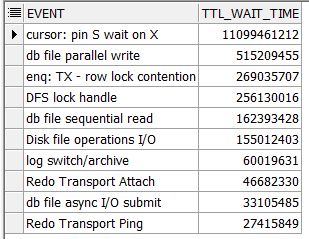I will explain V$Active_session_history | Active Session History in Oracle in this post.

V$Active_session_history | Active Session History in Oracle
V$ACTIVE_SESSION_HISTORY is one of the most important Oracle views that displays sampled session activity in the database. It contains snapshots of active database sessions taken once a second.
A database session is considered active if it was on the CPU or was waiting for an event that didn’t belong to the Idle wait class. Refer to the V$EVENT_NAME view for more information on wait classes.
V$Active_session_history Columns
| Column | Datatype | Description |
|---|---|---|
SAMPLE_ID | NUMBER | ID of the sample |
SAMPLE_TIME | TIMESTAMP(3) | Time at which the sample was taken |
SESSION_ID | NUMBER | Session identifier; maps to V$SESSION.SID |
SESSION_SERIAL# | NUMBER | Session serial number (used to uniquely identify a session’s objects); maps to V$SESSION.SERIAL# |
USER_ID | NUMBER | Oracle user identifier; maps to V$SESSION.USER# |
SQL_ID | VARCHAR2(13) | SQL identifier of the SQL statement that the session was executing at the time of sampling |
SQL_CHILD_NUMBER | NUMBER | Child number of the SQL statement that the session was executing at the time of sampling |
SQL_PLAN_HASH_VALUE | NUMBER | Numerical representation of the SQL plan for the cursor. This information might not be available for all session samples. V$SESSION does not contain this information. |
FORCE_MATCHING_SIGNATURE | NUMBER | The signature used when the CURSOR_SHARING parameter is set to FORCE |
SQL_OPCODE | NUMBER | Indicates what phase of operation the SQL statement was in; maps to V$SESSION.COMMANDSee Also: “V$SESSION” for information on interpreting this column |
SERVICE_HASH | NUMBER | Hash that identifies the Service; maps to V$ACTIVE_SERVICES.NAME_HASH |
SESSION_TYPE | VARCHAR2(10) | Session type:
|
SESSION_STATE | VARCHAR2(7) | Session state:
|
QC_SESSION_ID | NUMBER | Query coordinator session ID. This information is only available if the sampled session is a parallel query slave. For all other sessions, the value is 0. |
QC_INSTANCE_ID | NUMBER | Query coordinator instance ID. This information is only available if the sampled session is a parallel query slave. For all other sessions, the value is 0. |
BLOCKING_SESSION | NUMBER | Session identifier of the blocking session. Populated only when the session was waiting for enqueues or a “buffer busy” wait. Maps to V$SESSION.BLOCKING_SESSION. |
BLOCKING_SESSION_STATUS | VARCHAR2(11) | Status of the blocking session:
|
BLOCKING_SESSION_SERIAL# | NUMBER | Serial number of the blocking session |
EVENT | VARCHAR2(64) | If SESSION_STATE = WAITING, then the event for which the session was waiting for at the time of sampling.If SESSION_STATE = ON CPU, then this column will be NULL.See Also: Appendix C, “Oracle Wait Events” |
EVENT_ID | NUMBER | Identifier of the resource or event for which the session is waiting or for which the session last waited. Interpretation is similar to that of the EVENT column. |
EVENT# | NUMBER | Number of the resource or event for which the session is waiting or for which the session last waited. Interpretation is similar to that of the EVENT column. |
SEQ# | NUMBER | Sequence number that uniquely identifies the wait (incremented for each wait) |
P1TEXT | VARCHAR2(64) | Text of first additional parameter |
P1 | NUMBER | First additional parameter |
P2TEXT | VARCHAR2(64) | Text of second additional parameter |
P2 | NUMBER | Second additional parameter |
P3TEXT | VARCHAR2(64) | Text of third additional parameter |
P3 | NUMBER | Third additional parameter |
WAIT_CLASS | VARCHAR2(64) | Wait class name of the event for which the session was waiting at the time of sampling. Interpretation is similar to that of the EVENT column. Maps to V$SESSION.WAIT_CLASS. |
WAIT_CLASS_ID | NUMBER | Wait class identifier of the event for which the session was waiting at the time of sampling. Interpretation is similar to that of the EVENT column. Maps to V$SESSION.WAIT_CLASS_ID. |
WAIT_TIME | NUMBER | 0 if the session was waiting at the time of samplingTotal wait time for the event for which the session last waited if the session was on the CPU when sampledWhether or not |
TIME_WAITED | NUMBER | If SESSION_STATE = WAITING, then the time that the session actually spent waiting for that EVENT. This column is set for waits that were in progress at the time the sample was taken.If a wait event lasted for more than a second and was caught waiting in more than one session sample row, then the actual time spent waiting for that wait event will be populated in the last of those session sample rows. At any given time, this information will not be available for the latest session sample. |
XID | RAW(8) | Transaction ID that the session was working on at the time of sampling. V$SESSION does not contain this information. |
CURRENT_OBJ# | NUMBER | Object ID of the object that the session is referencing. This information is only available if the session was waiting for Application, Cluster, Concurrency, and User I/O wait events. Maps to V$SESSION.ROW_WAIT_OBJ#. |
CURRENT_FILE# | NUMBER | File number of the file containing the block that the session is referencing. This information is only available if the session was waiting for Cluster, Concurrency, and User I/O wait events. Maps to V$SESSION.ROW_WAIT_FILE#. |
CURRENT_BLOCK# | NUMBER | ID of the block that the session is referencing. This information is only available if the session was waiting for Cluster, Concurrency, and User I/O wait events. Maps to V$SESSION.ROW_WAIT_BLOCK#. |
PROGRAM | VARCHAR2(48) | Name of the operating system program |
MODULE | VARCHAR2(48) | Name of the executing module when sampled, as set by the DBMS_APPLICATION_INFO.SET_MODULE procedure |
ACTION | VARCHAR2(32) | Name of the executing module when sampled, as set by the DBMS_APPLICATION_INFO.SET_ACTION procedure |
CLIENT_ID | VARCHAR2(64) | Client identifier of the session; maps to V$SESSION.CLIENT_IDENTIFIER |
Oracle Database Admin should know what is the database load profile and Active Session load to compare it when the complaint comes from Customer.
Oracle Database admin should find average database load profile metric values for normal times. Because When customer complain from Slowness then DBA can find actual load profile metric values and compare it from average load profile value.
You can find average Active session of database with following script.
SELECT 'Load', CASE WHEN ( ( CAST (end_time.sample_time AS DATE) - CAST (start_time.sample_time AS DATE)) * 24 * 60 * 60) = 0 THEN 0 ELSE ROUND ( ( COUNT (ash.sample_id) / ( ( CAST (end_time.sample_time AS DATE) - CAST (start_time.sample_time AS DATE)) * 24 * 60 * 60)), 2) END AS Average_Active_Session FROM (SELECT MIN (sample_time) sample_time FROM v$active_session_history ash WHERE sample_time BETWEEN SYSDATE - 1 / 1440 AND SYSDATE) start_time, (SELECT MAX (sample_time) sample_time FROM gv$active_session_history WHERE sample_time BETWEEN SYSDATE - 1 / 1440 AND SYSDATE) end_time, gv$active_session_history ash WHERE ash.sample_time BETWEEN start_time.sample_time AND end_time.sample_time GROUP BY end_time.sample_time, start_time.sample_time;
When you take many complaints from customer about slowness of database, you should check Oracle database wait events.
You can check Top Oracle database wait events from Active session history which is v$active_session_history queries with below script.
select * from ( select active_session_history.event, sum(active_session_history.wait_time + active_session_history.time_waited) ttl_wait_time from gv$active_session_history active_session_history where active_session_history.event is not null group by active_session_history.event order by 2 desc) where rownum <= 10;
Query result is like below screenshot.

Read the following post to learn more details about V$ views.
Do you want to learn Oracle Database Performance Tuning detailed, then read the following articles.
Performance Tuning and SQL Tuning Tutorial in the Oracle Database
 IT Tutorial IT Tutorial | Oracle DBA | SQL Server, Goldengate, Exadata, Big Data, Data ScienceTutorial
IT Tutorial IT Tutorial | Oracle DBA | SQL Server, Goldengate, Exadata, Big Data, Data ScienceTutorial